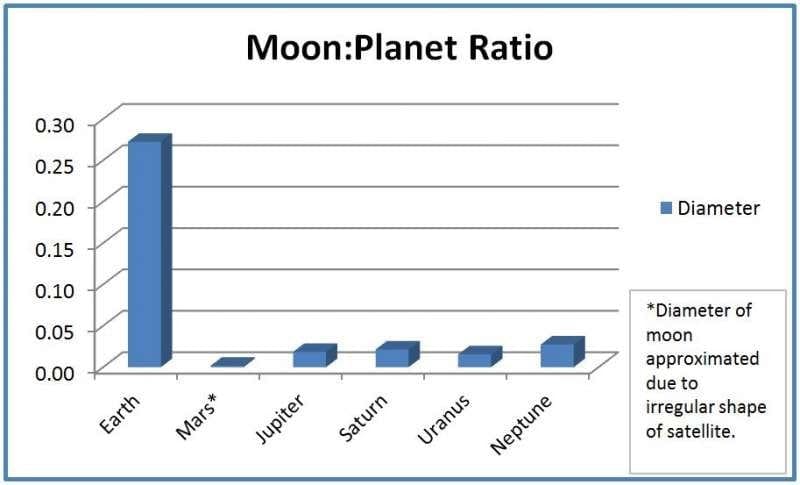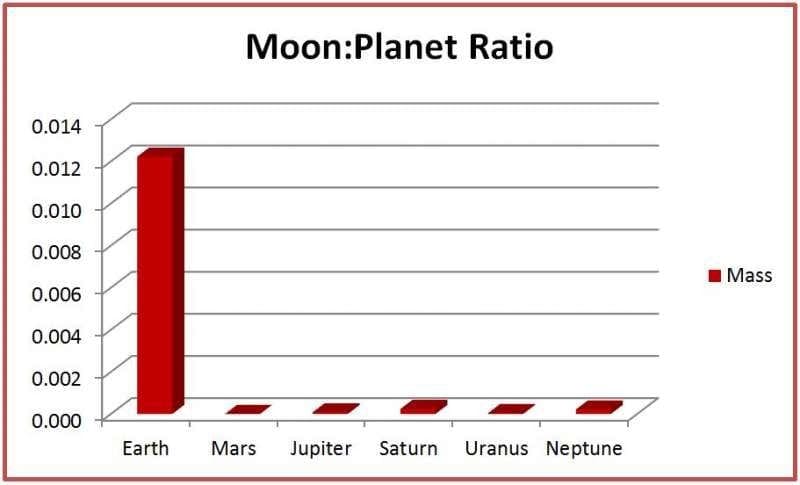Overview
In this second article on Our Amazing Moon we will examine the unique properties of our moon’s size as it relates to the size of the earth; and, we will examine the position of the moon in its orbit relative to our distance from the Sun. These are just two of many unique features of our moon that point to its design and placement with purpose in our sky.
Size Relationship to Earth vs. Other Planetary Satellites
The earth’s moon is significantly larger proportionately to the planet that it orbits than any other moon in our solar system1.
Among the many reasons why the physical size of our moon is significant are the following: Light reflection at night Visibility during daylight
Regulation of oceanic tides
Stabilization of ‘orbital wobble’
In upcoming articles we will be discussing these, and other benefits and features unique to earth’s moon in our solar system. Meanwhile, we should keep in mind that every aspect of our moon’s size, mass, location, and orbital plane make it possible for us to live on planet earth.
Referring to Figure 1 we clearly see that the ratio of our moon’s diameter to that of the earth is far greater than that of the largest moon of any of the other planets in our solar system to the planet which they orbit. In fact, the diameter of the earth’s moon is over ¼ that of earth’s diameter. The next moon that comes closest to its parent planet in size is Neptune’s largest moon, Triton. By comparison, Triton has a diameter that is less than 3/100 that of Neptune. This makes the earth’s moon comparatively larger than its nearest competitor by a factor of 10!

This significant physical size of the Moon coupled with its closeness to the earth make it the most visible object in the sky (after the Sun) in both clear day and night skies, even when it is partially obscured by the Earth. In fact, the only time we cannot see the Moon is if it is either below the horizon, or completely obscured by the shadow of the Earth – called a ‘new moon’.
No other moon in our solar system can be viewed from its home planet with the degree of brilliance and dominance that our moon can from the surface of earth.
Every aspect of our moon’s size, location, and orbital plane make it possible for us to live on planet earth.
In Figure 2 we see the relationship between the masses (amount of matter) of the largest moons orbiting each planet and that of their home planet. Again, the earth’s moon stands out as being far more massive compared to its planet than any other moon. In fact, the next closest moon is Saturn’s Titan whose ratio is almost 52 times less than that of the Moon-to-Earth ratio!

No other moon in our solar system can be viewed from its home planet with the degree of brilliance and dominance that our moon can from the surface of earth.
As we shall see in upcoming articles, lunar mass plays an important role the way that our moon regulates our oceanic tides and stabilizes our orbit as we revolve about the Sun. One of the most critical aspects of maintaining our orbital stability is the progression of the seasons in each hemisphere.
Size Relationship to Sun vs. Distance to Earth
The size and position of our moon as they relate to the size and distance earth is from our sun allows for a total solar eclipse on the earth’s surface while revealing only the corona of the sun.
The feature image for this article is an artist’s depiction of a total solar eclipse.
The next total solar eclipse in North America is scheduled to occur on August 12, 20172.
In Psalm 19:1 we read, “The heavens declare the glory of God; and the firmament sheweth his handywork.” The unique size and distance relationship between the Moon and the Sun to the Earth is a clear example of a work in the ‘heavens’ that is manifested in our sky (firmament).

Figure 3 above is an illustration of the relationship between the three aforementioned bodies during the time of a solar eclipse. The Earth is shown on the far left in blue, the Sun to the far right in orange, and the Moon is between the two nearer the Earth in brown.
Even though the Sun is approximately 400 times further away from Earth than the Moon, it also just happens to be approximately 400 times greater in diameter than the Moon as well. That means that the ends of its diameter form almost exactly the same angle with a point on the Earth as do the ends of the diameter of the Moon.
Because of this phenomenon, the entire landscape beneath the total solar eclipse takes on an eerie twilight appearance, the temperature drops a few degrees, and wildlife often becomes still and quiet as if it were late evening.
During this time a visually stunning event takes place overhead in the daytime sky as well. The Sun’s corona, brilliant in its own right (but normally invisible due to the overwhelming brightness of the solar disc) can be clearly seen as the Sun is completely blocked by the Moon.
The unique size and distance relationship between the Moon and the Sun to the Earth is a clear example of a work in the ‘heavens’ that is manifested in our sky.
If the Moon was just a little bit closer to the Earth it would completely obscure the sun from view during a total solar eclipse. If it were just a bit further away it would not obscure enough to create a total eclipse. The same would be true if the Moon was in the same location but happened to be slightly larger or smaller respectively.
The bottom line is that the Moon is precisely the correct size and at the correct orbital distance to create a spectacular total solar eclipse that blots out the entire solar disc and allows viewers on Earth a rare glimpse of its surrounding corona.
Summary
In this brief article we have already seen a number of unique features of our moon and its relationship to our earth and sun that make any random or coincidental explanation highly unlikely. Furthermore, of the six planets orbiting in the ecliptic plane in our solar system that have moons, only our moon has all of the properties discussed relative to its home planet.
God’s Word tells us that He has created all things, and that all things He has created have a specific purpose. That includes everything from our own moon to you and me! We can truly rest in His promise from 1 Corinthians 1:17 which tells us, “And he is before all things, and by him all things consist.”
In His Love,
Dr. Jack L. Burton
-Hebrews 11:1-3
References
(1) NASA Planetary Fact Sheets and associated satellite data sheets.
http://nssdc.gsfc.nasa.gov/planetary/planetfact.html
(2) TheSky Astronomy Software © 1984-2000. Software Bisque, Inc.
(3) Sciencing.com. An Animal’s Reaction to a Solar Eclipse. Ethan Shaw.
http://sciencing.com/animals-reaction-solar-eclipse-3503.html
End Notes
- Since Mercury and Venus have no moons they are not included in the data.
- Follow this link for more information on the 2017 solar eclipse
https://www.timeanddate.com/eclipse/solar/2017-august-21
Notes
- All Bible quotes in this article are taken from the KJV.
- Bible passages in double quotes (“) appear exactly as found in the KJV.
- Bible passages in single quotes (‘) have been modified for emphasis or ease of reading only (such as capitalization of pronouns referring to God, bolded text, or modernized punctuation, etc.) without altering the actual wording of the text.
Disclaimer: While to the author’s knowledge all of the information cited in the referenced material related directly to the content of this article is correct and accurate, the author in no way endorses any of the cited references in their entirety – especially where the material contained therein is in direct contradiction with the Creation account given in the Word of God.








Two brief items to consider:
I don’t think a new moon is when the moon is obscured by the earth’s shadow–that’s a lunar eclipse. I think a new moon is when the moon is between the sun and the earth.
Also, the eclipse is scheduled for August 21, 2017 (not the 12th). We are quite excited about it here in Columbia SC because we are right in the path.
Tim,
Thanks for your comments on this (and other) articles of mine here on The Creation Club!
I wanted to address this one first because you have caught a couple of ‘typos’ which I very much appreciate.
1. You are correct regarding the lunar eclipse. The sentence you are citing should read:
“In fact, the only time we cannot see the Moon is if it is either below the horizon, or completely obscured by its own shadow – called a ‘new moon’.” As you probably know the moon remains visible during a total solar eclipse, it just changes color to a deep red or maroon.
2. The correct date for this year’s total solar eclipse is indeed Monday, August 21, 2017. This is one of my ‘transposition’ typos (’12’ instead of ’21’).
For others who may be reading these responses, here is a good site for info on the upcoming Total Solar Eclipse, path of totality, and events across the nation:
https://eclipse2017.nasa.gov/
Thanks again for your comments, Tim.
Be on the lookout for my responses to your comments on my other articles!
In Christ’s Love,
Jack B.